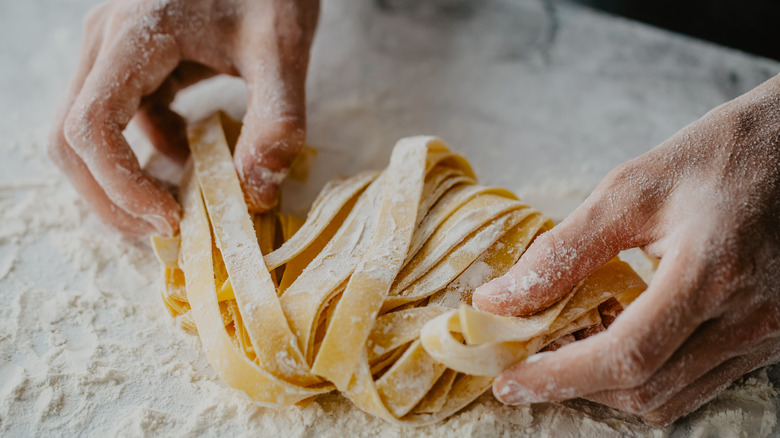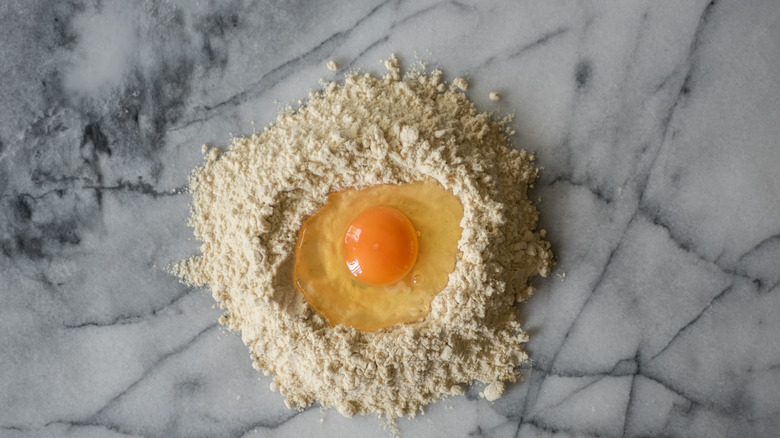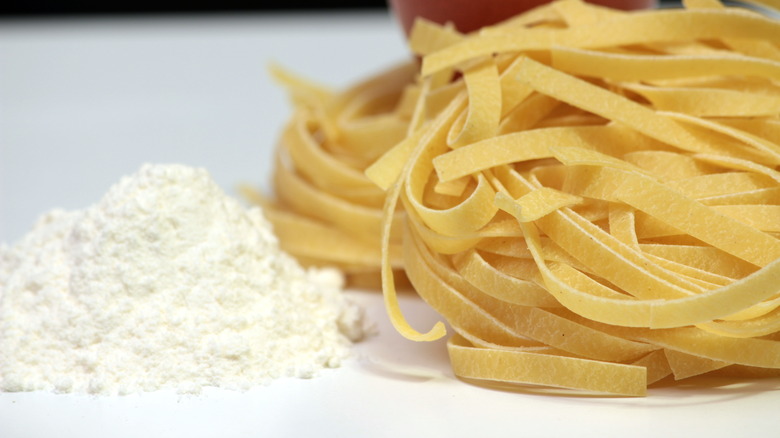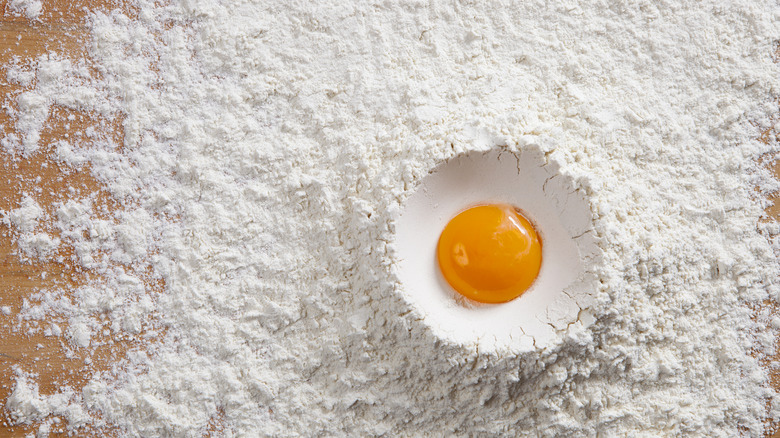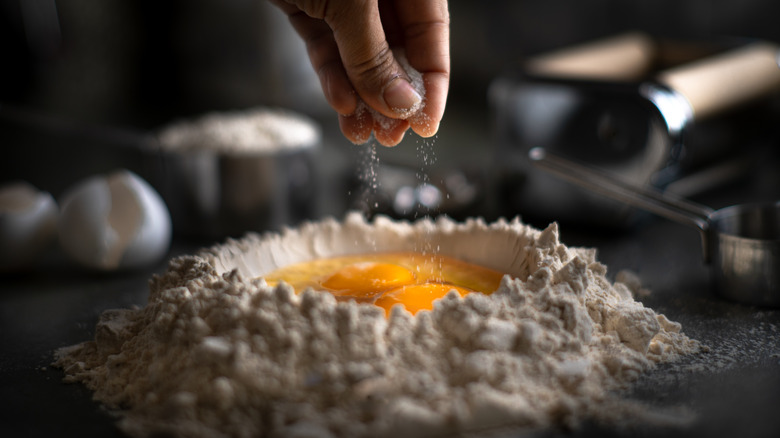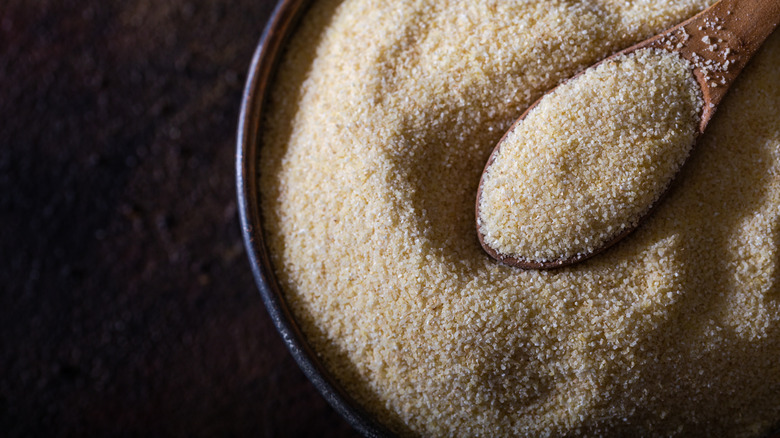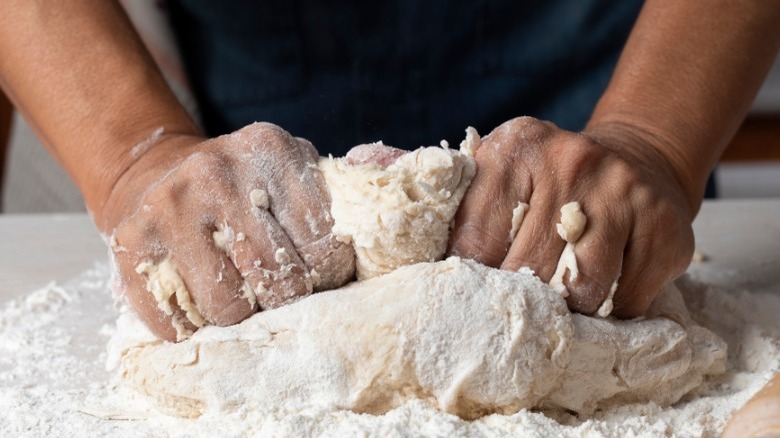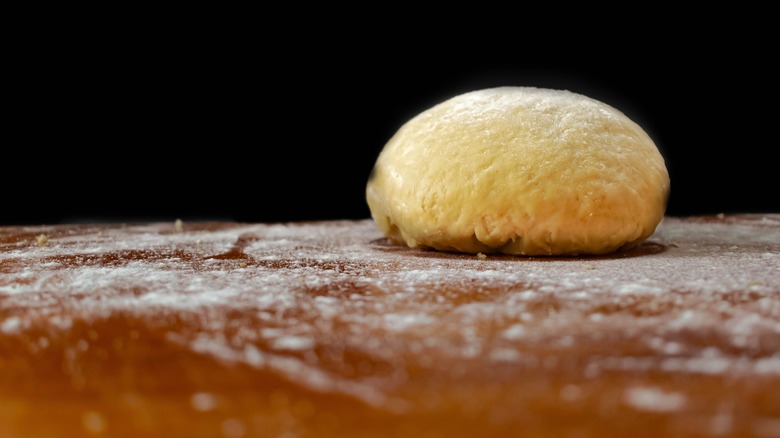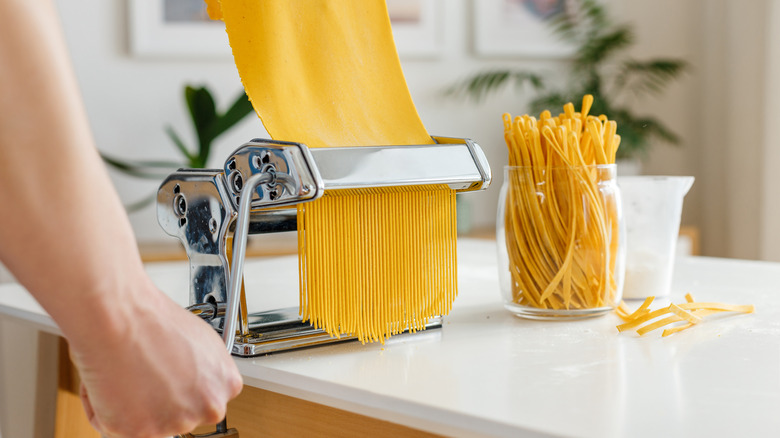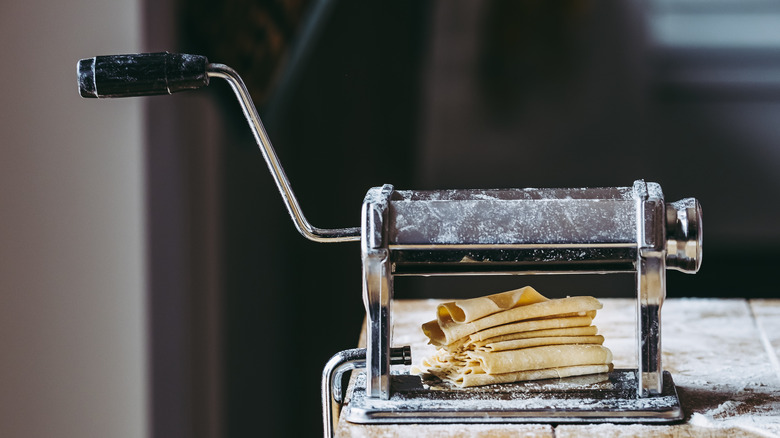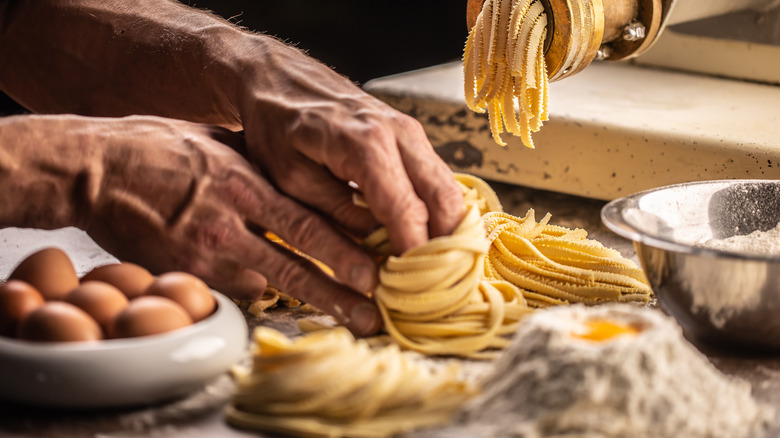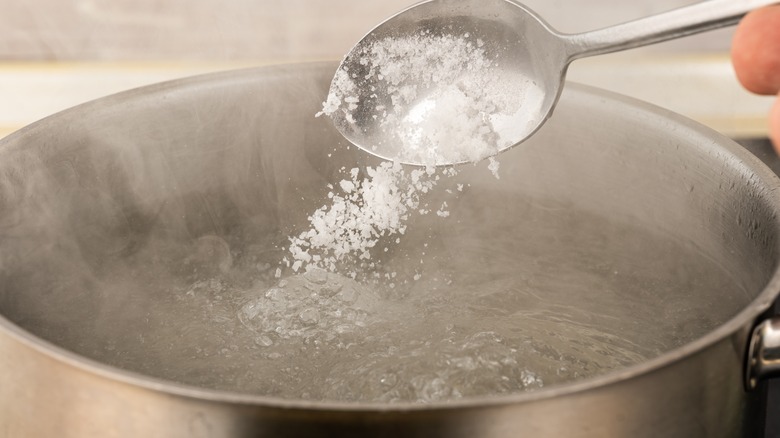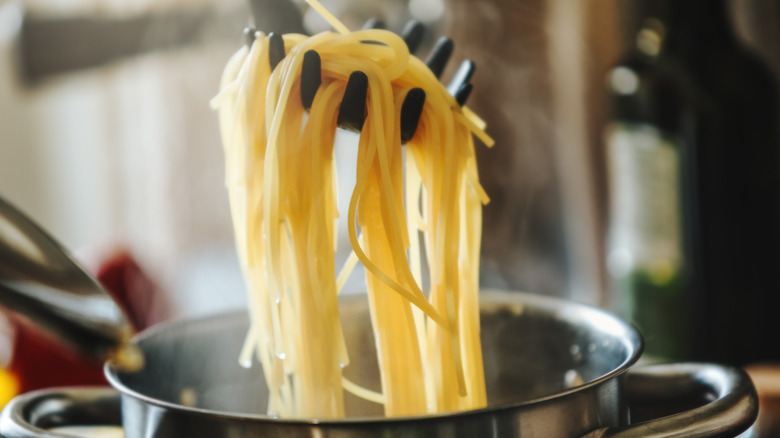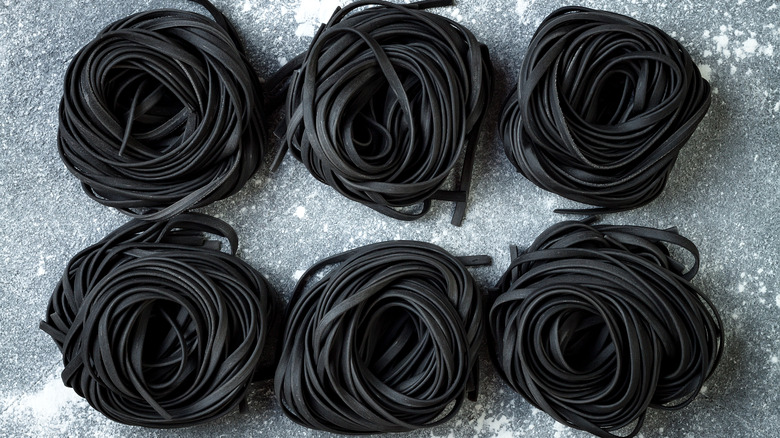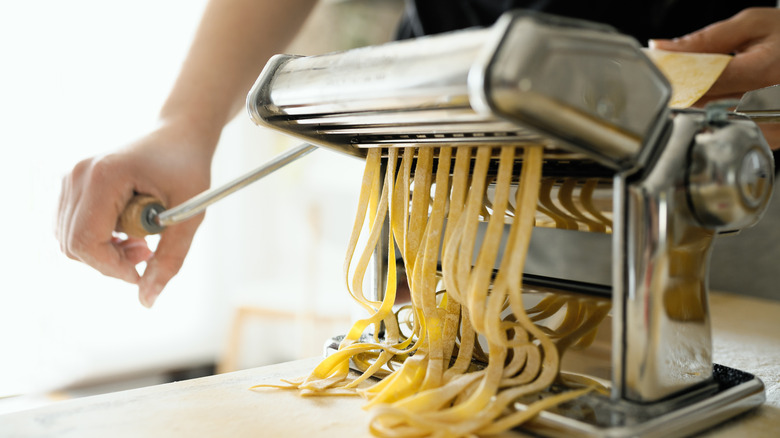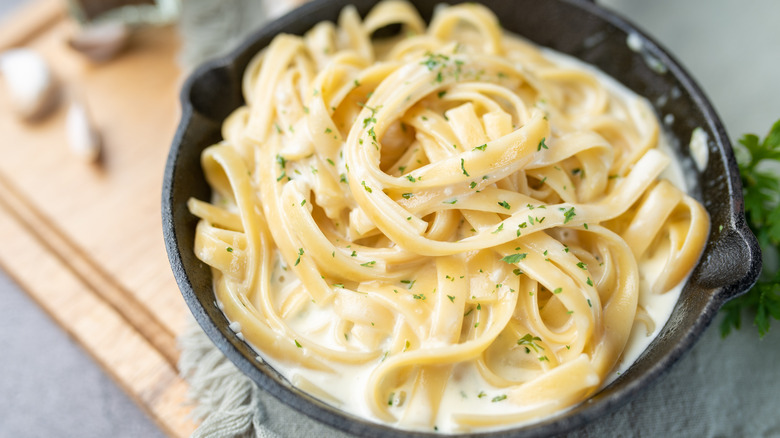15 Mistakes To Avoid When Making Fresh Pasta
Making fresh pasta is undoubtedly an act of love. While it may be easier to pick up a box of dried pasta at the grocery store or browse the fresh pasta section at your local Italian shop, making your own homemade pasta is a much more gratifying experience. Making pasta is a worthwhile experience because you can use ingredients to fit your specific dietary preferences, such as organic or gluten-free flour, or add your favorite extracts to flavor your pasta with herbs or coloring powders. You can also shape your pasta into whatever style you like, like a fettuccini or a stuffed ravioli. When the pasta is in your hands, the possibilities are endless.
Yet, one of the reasons why people don't make their own pasta is because of how laborious the process is and how temperamental pasta dough can be. If you're trying to make your first batch of homemade pasta, we've done some of the legwork to ensure pure pasta bliss.
Not using the well method to mix your pasta
If you read a pasta recipe, you'll likely see something about dropping your eggs into a flour well. This step is an integral part of pasta making — not just a step added to the recipe to make your life more complicated. Several Redditors note that using a well shape means slowly bringing the flour's edges into the eggs. You can stop mixing the flour into the dough once it reaches the perfect texture. Since eggs vary in weight and consistency, your recipe won't always be the most consistent mixture if you add your flour by grams and your eggs precisely. Pasta making is an art, after all.
If you're making large quantities of pasta, using this well method with flour is impractical. Instead, you can use a modern KitchenAid stand mixer with a hook attachment to combine your eggs and flour.
Using the wrong type of flour
According to Fabulous Pasta, the standard flour for pasta is double zero (00 or doppio zero). This flour is originally made in Italy, where it is used to make both pizza and pasta (via Fine Dining Lovers). The 00 means that the flour is ground as finely as possible and goes up to 0, 1, or 2. 00, or occasionally 0 flour, is used for pasta making because this type of flour contains between 10% and 15% protein. The respective gluten level allows you to stretch the dough without it breaking. Fine Dining Lovers notes that you can purchase pizza 00 or pasta 00; the pizza version contains slightly more gluten but can be substituted for pasta flour in a pinch.
Cake or pastry flour, while it contains a low amount of protein and gluten, would take a lot of kneading to get it to the texture of pasta dough. Bread flour has too much protein, making the pasta too sticky and dense.
Using too many egg whites
Making homemade pasta is simple on the ingredient end of things — you just need eggs and flour. The yolk of the egg provides a beautiful yellow hue to the pasta and a fatty flavor to the noodle. While adding egg yolks can help increase the moisture content of the pasta and make it more pliable, adding a ton of egg white can create issues with the texture and moisture of your pasta. Meryl Feinstein from the Pasta Social Club recommends using both egg yolks and whole eggs to get the optimal dough texture (via Food52).
You might see some recipe for pasta dough that doesn't use eggs at all and instead derives its hydration from water. Egg-less pasta is common for shapes like orecchiette, which are more sturdy and tough than egg-based pasta dough. If you're making rolled pasta, you should stick to using eggs as a cornerstone ingredient.
Not using the correct dry-to-wet ingredient ratio
Making superb pasta dough is all about finding the perfect dry and wet ingredients ratio. The ideal ratio of wet to dry ingredients is 3-to-4. If you're making egg-free pasta dough with water and flour, you should instead use a 1-to-2 ratio (via Pasta Social Club).
The key to getting the perfect ratio is methodically weighing out all your pasta dough's ingredients. This means investing in the most utilitarian kitchen tool ever — an electronic scale. This device allows you to measure both by weight and by volume. You should always use the gram measurement on your scale for the eggs, water, and flour. This will ensure you get the most accurate ratio of ingredients to add to your pasta recipe. Making minor mistakes, like forgetting to tare your scale or measuring in fluid ounces for liquid, can create problems later in the cooking process.
Not adding semolina
Semolina is another ingredient you need to add to your fresh pasta besides 00 flour. Semolina, per Bob's Red Mill, is a type of flour made from durum wheat (or "pasta wheat"). At first glance, semolina is much coarser than 00 flour and may have a more golden color, depending on the variety. The smell of semolina is much more organic and flavorful than flour, thus making it a pleasant ingredient for food like semolina cake (basbousa).
Semolina is a critical ingredient for pasta because it has high gluten and protein content, which can help the pasta retain its shape when cooking. If you're shopping for semolina in your grocery store, you should always look for durum semolina — not corn or rice semolina. Corn and rice semolina are just labeled as "semolina" because they're coarsely ground, not because they're substitutes for the traditional wheat variety in pasta.
Under-kneading your pasta dough
In order for your pasta to keep its shape, you'll need to knead it — and knead it a lot. Giada De Laurentiis' pasta recipe requires close to eight minutes of kneading to ensure that the gluten is well-developed and sturdy. Failing to knead out your pasta dough may lead to your pasta crumbling when it hits the water.
According to Eataly, the best method for kneading your pasta dough is to press the dough with the heel of your hand and slowly push it away from you. Then, graduate to using your knuckles to press and move the dough, flipping and rotating the dough constantly. Eataly notes that kneading your dough can take up to 20 minutes — or whenever the texture of the dough is smooth. If your dough starts to crumble, you can add a bit of water or a tablespoon of 00 flour at a time to keep the dough from becoming too watery.
If you don't want to do the arm workout, you can turn to your stand mixer. According to KitchenAid, kneading the dough with your stand mixer and a dough hook can be ready to rest in five minutes.
Forgetting to rest your pasta dough
Your dough needs to rest between kneading and rolling. If your pasta dough is firm, springy, and difficult to work out, it indicates that the gluten in your dough needs time to relax and soften. Resting your pasta dough after you knead it allows the dough to strengthen the gluten. Eataly recommends resting your dough for a minimum of 30 minutes. Also, make sure to cover the entire dough in plastic wrap to ensure the dough doesn't form a skin.
According to La Micia Cooking, egg-based pasta dough should be rested for at least twenty minutes but less than an hour. And although you might think that egg-based dough should always be refrigerated, think again. The dough is easier to work with if you leave it out at room temperature, and an hour of resting outside the fridge at room temperature will not increase the risk of foodborne illness — just don't eat the raw dough (via the CDC).
Rolling out your pasta by hand
After you've kneaded and rested your fresh dough, it's time to start rolling out your pasta. And while old-fashioned Italian grandmothers likely didn't have fancy equipment and pasta rollers, you're going to want to grab a pasta roller instead of a rolling pin. To get your pasta dough super thin, you'll need a handheld pasta roller.
There are numerous types of pasta rollers you can purchase. If you already have a stand mixer, you can purchase a pasta roller attachment with eight sizes to roll your pasta to the perfect thickness. If you prefer a tabletop pasta roller, you can purchase one from Amazon for less than $50. These metal appliances clip to your countertop so they won't move around while you're making your pasta. You'll want to cut the dough into small segments so you can roll it through the pasta maker on the highest setting. Then, you'll slowly start to thin out the pasta until it reaches your desired thickness.
Not laminating your pasta dough
You've probably heard the term "laminating" used to refer to croissants and buttery pastry dough, but what about pasta? According to Seasoned Cooks, laminating the pasta dough is the action of feeding it through the roller, folding it over on itself, and feeding it back into the roller. Once you've rolled the dough through on the thickest setting, dust the piece with flour and fold the dough in half. Then, you should cut the edges off the dough to form it into a square. Laminating is an important stage of the dough is important to strengthen the gluten, which in turn prevents the dough from ripping as it goes through the roller.
Seasoned Cooks notes that you only have to laminate for the first two to three rotations — you can also use the laminating technique to add fresh herbs to your dough. Once your square is ready to go, you can cut off the edges of the dough to add it to the scrap pile.
Adding white flour to keep your dough from sticking
If you're working with dough and your pasta starts sticking, your inclination might be to add more flour to cover the pasta. When you're ready to cut your pasta, you should use rice flour or semolina to prevent the dough from sticking together. If you add 00 flour, it will soak back into the pasta and put you in the same predicament. When you go to cook your pasta, you'll find a layer of gummy residue on the exterior of the pasta. Denser flours, like semolina, will sink to the bottom of the pot when you boil the pasta and prevent your water from getting cloudy.
Another great tip is to add a couple of teaspoons to a bowl underneath the machine. That way, you won't have to activate the gluten more if you handle it to put it with the semolina.
Not salting the water for your pasta
There are a lot of myths and questions about how much salt you need to add to pasta water. If you don't add enough salt to your pasta water, you'll risk bland, lackluster pasta. The average amount of salt added to the water, as reported across several outlets, was 1½ teaspoons per liter of water. Other sources recommend using as much as 1 tablespoon of salt per pound of pasta. America's Test Kitchen notes that you can use whatever type of salt you have to season your pasta water. But since it's going to get boiled away anyway, you might as well use your cheap table or Kosher salt instead of your expensive Maldon salt.
AstroCamp recommends adding salt to your water after it's already boiling. This is because the chemical composition of salt increases its boiling point and means that you'll be waiting over the stove for it to boil. After you've added the salt, you can add your pasta to the pot and cook accordingly.
Overcooking fresh pasta
It's very easy to overcook any kind of pasta. But fresh pasta is especially easy to overcook because it requires less time than dry pasta. To cook the perfect serving of fresh pasta, you'll need to bring a pot of salted water to a rapid boil on the stove. Remember, you should always stir the pasta immediately after placing it in the pot to prevent the noodles from sticking to one another. The exact cooking time will depend on the thickness of the pasta and if you want it al dente or not. The average amount of time needed to cook most fresh pasta is between 90 seconds and four minutes.
You should avoid rinsing your pasta with cold water once you remove it from the pot. According to Delallo, rinsing pasta dough will cause it to cool rapidly and reduce any opportunity for the sauce to stick to the noodles. The only time where this is acceptable is if you're using the pasta for a cold salad.
Not trying colored pasta
While we admit that the yellow hue of egg-based pasta is beautiful, there are so many more creative colors you can impart to your pasta dough. Pasta gets its different colors from dyes and coloring agents added to the dough with your other ingredients. If you want a bright, vibrant red, you can use beetroot juice or powder. The powder is ideal for pasta because adding liquid can throw off the precarious liquid-to-flour ratio. If you want mysterious black pasta, you should add a bit of squid ink to your pasta. Add the ink to your pasta with the yolks and a bit of olive oil for a dark black hue. If you want green pasta, add a bit of dried spinach power to your pasta with the flour — the mild spinach flavor complements a nutty, fresh pesto sauce with notes of parmesan, basil, and pine nuts.
Washing your pasta machine
Taking proper care of your pasta machine is key to ensuring you get a consistent pasta recipe. To care for your pasta machine, you may be inclined to wash your pasta machine. Remember, you should never wash your pasta machine in a dishwasher or a sink. Mixing water with leftover specks of flour or dough pieces will create a gummy mess that makes cleaning even more difficult.
Rolling polymer clay inside the machine can help tidy it (via Pasta Evangelists). To use this method, shape a wad of clay into your ball and roll it in the machine like its pasta dough. You can also use a brush to clean the machine or take a damp cloth to remove the leftover flour residue. To avoid rust, be sure to air-dry your machine before storing it. Rust in the inside of your machine may discolor your pasta and impart a metallic taste to your fettuccini.
Not pairing your pasta with your sauce
Pasta is nothing without the sauce it's paired with. If you're making bolognese, a thick meat sauce with tomato and Italian herbs, you should pair it with a thick pasta that can support the weight of the sauce, like a tagliatelle. If you're making your batch of pesto, you should pair it with a pasta shape that can hold and soak up the sauce — like fusilli, rotini, and farfalle.
The general rule of thumb when it comes to pasta pairings is to use dainty noodles for dainty sauces and heavy noodles for heavy sauces. Long thin noodles, like bucatini and perciatelli, are best for thin sauces that allow the sauce to flow through the noodle. If you're making a pasta casserole, try using short pasta shapes with a lot of tube space to support your favorite creamy sauces and dreamy macaroni and cheese recipe.
